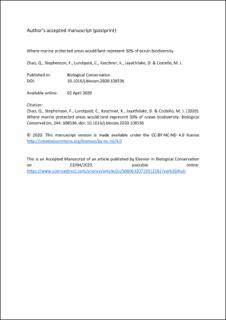| dc.contributor.author | Zhao, Qianshuo | |
| dc.contributor.author | Stephenson, Fabrice | |
| dc.contributor.author | Lundquist, Carolyn | |
| dc.contributor.author | Kaschner, Kristin | |
| dc.contributor.author | Jayathilake, Dinusha R.M. | |
| dc.contributor.author | Costello, Mark John | |
| dc.date.accessioned | 2021-01-25T07:49:18Z | |
| dc.date.available | 2021-01-25T07:49:18Z | |
| dc.date.created | 2020-11-17T22:49:15Z | |
| dc.date.issued | 2020 | |
| dc.identifier.citation | Zhao, Q., Stephenson, F., Lundquist, C., Kaschner, K., Jayathilake, D. & Costello, M. J. (2020). Where marine protected areas would best represent 30% of ocean biodiversity. Biological Conservation, 244: 108536. doi: | en_US |
| dc.identifier.issn | 1873-2917 | |
| dc.identifier.uri | https://hdl.handle.net/11250/2724382 | |
| dc.description | Author's accepted version (postprint). | en_US |
| dc.description | This is an Accepted Manuscript of an article published by Elsevier in Biological Conservation on 02/04/2020. | |
| dc.description | Available online: https://www.sciencedirect.com/science/article/pii/S0006320719312182?via%3Dihub | |
| dc.description.abstract | The IUCN (the International Union for Conservation of Nature) World Conservation Congress called for the full protection of 30% of each marine habitat globally andat least 30% of all the ocean. Thus, we quantitatively prioritized the top 30% areas for Marine Protected Areas (MPAs) globally using global scale measures ofbiodiversity from the species to ecosystem level. The analysis used (a) Ecosystems mapped based on 20 environmental variables, (b) four Biomes (seagrass, kelp,mangrove, and shallow water coral reefs) plus seabed rugosity as a proxy for habitat, and (c) species richness within each biogeographic Realm (indicating areas ofspecies endemicity), so as to maximise representivity of biodiversity overall.We found that the 30% prioritized areas were mainly on continental coasts, island arcs, oceanic islands, the southwest Indian Ridge, the northern Mid-AtlanticRidge, the Coral Triangle, Caribbean Sea, and Arctic Archipelago. They generally covered 30% of the Ecosystems and over 80% of the Biomes. Although 58% of theareas were within countries Exclusive EconomicZones(EEZ), only 10% were in MPAs, and < 1% in no-take MPAs (IUCN category Ia). These prioritized areas indicatewhere it would be optimal to locate MPAs for recovery of marine biodiversity within and outside country's EEZ. Our results thus provide a map that will aid bothnational and international planning of where to protect marine biodiversity as a whole. | en_US |
| dc.language.iso | eng | en_US |
| dc.publisher | Elsevier | en_US |
| dc.rights | Attribution-NonCommercial-NoDerivatives 4.0 Internasjonal | * |
| dc.rights.uri | http://creativecommons.org/licenses/by-nc-nd/4.0/deed.no | * |
| dc.title | Where marine protected areas would best represent 30% of ocean biodiversity | en_US |
| dc.type | Peer reviewed | en_US |
| dc.type | Journal article | en_US |
| dc.description.version | acceptedVersion | en_US |
| dc.subject.nsi | VDP::Matematikk og Naturvitenskap: 400::Zoologiske og botaniske fag: 480::Marinbiologi: 497 | en_US |
| dc.subject.nsi | VDP::Matematikk og Naturvitenskap: 400::Zoologiske og botaniske fag: 480::Økologi: 488 | en_US |
| dc.source.pagenumber | 11 | en_US |
| dc.source.volume | 244 | en_US |
| dc.source.journal | Biological Conservation | en_US |
| dc.identifier.doi | 10.1016/j.biocon.2020.108536 | |
| dc.identifier.cristin | 1848972 | |
| dc.source.articlenumber | 108536 | en_US |

